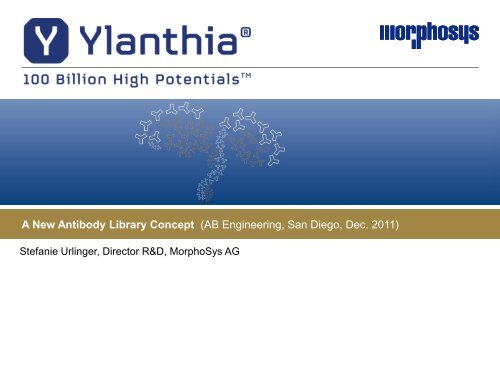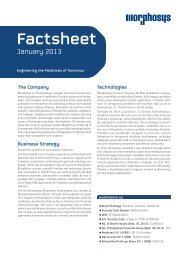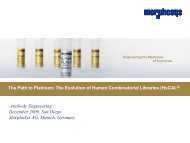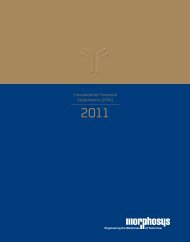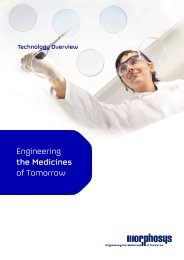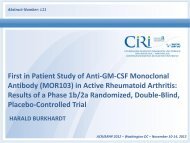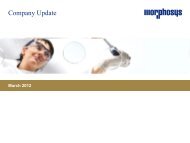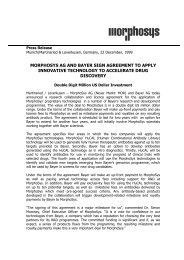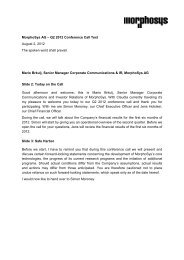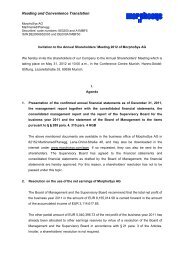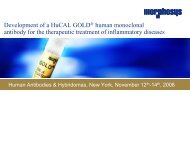Antibody Engineering Conference, San Diego - MorphoSys
Antibody Engineering Conference, San Diego - MorphoSys
Antibody Engineering Conference, San Diego - MorphoSys
Create successful ePaper yourself
Turn your PDF publications into a flip-book with our unique Google optimized e-Paper software.
A New <strong>Antibody</strong> Library Concept (AB <strong>Engineering</strong>, <strong>San</strong> <strong>Diego</strong>, Dec. 2011)<br />
Stefanie Urlinger, Director R&D, <strong>MorphoSys</strong> AG<br />
Page 1 2011 <strong>Antibody</strong> <strong>Engineering</strong><br />
© <strong>MorphoSys</strong> AG
Why a New <strong>Antibody</strong> Library?<br />
From: „Building Better <strong>Antibody</strong> Therapeutics“ by Patrick McGee, Drug Discovery<br />
and Development, 2007 (quotation Stephen Demarest, Biogen Idec):<br />
„The construction of nearly every human or humanized antibody drug candidate<br />
necessitates some unnatural protein engineering.“ […]<br />
„The only companies with success in this area are those that included stability and<br />
solubility as a key component of their library designs.“ […]<br />
„And while there have been many recent successes in this area, there have been<br />
numerous and costly failures over the past 15 years because stability was not always<br />
considered a key issue.“<br />
Building quality directly into the antibody library:<br />
Page 2 2011 <strong>Antibody</strong> <strong>Engineering</strong><br />
© <strong>MorphoSys</strong> AG
AGENDA<br />
1. Features of Ylanthia<br />
2. Realization of the Concept<br />
3. Quality Control<br />
4. Library Performance<br />
Page 3 2011 <strong>Antibody</strong> <strong>Engineering</strong> © © <strong>MorphoSys</strong> AG AG
Analyzing the Natural Human <strong>Antibody</strong><br />
Repertoire<br />
Ranking of most prominent<br />
variable region genes and<br />
VH/VL pairings:<br />
� Extraction of V gene usage and<br />
VH/VL pairing frequencies from<br />
own B-cell sequencing efforts and<br />
several publications analyzing<br />
both, autoimmune and healthy<br />
people*.<br />
� Analysis of VH/Vk as well as<br />
VH/Vλ pairings.<br />
Ranking according to natural<br />
occurrence.<br />
* Wardemann H. et al. Science (2003); Yurasov S. et al. JEM (2005); Tsuiji M. et al. JEM (2006); Yurasov S. et al. JEM (2006);<br />
Tiller T. et al. Immunity (2007); Mietzner B. PNAS (2008); Kofer J. et al: unpublished/ personal communication;<br />
Brezinschek H.P. et al. JCI (1997); Demaisson C. et al. Immunogenetics (1995); Foster S.J. at al. JCI (1997)<br />
VH<br />
Page 4 2011 <strong>Antibody</strong> <strong>Engineering</strong><br />
© <strong>MorphoSys</strong> AG<br />
V�
Selection of Top 20 HC and 20 LC Germline<br />
Genes<br />
Human antibody repertoire:<br />
� 40 functional Vkappa<br />
� 30 Vlambda<br />
� 50 VH segments germline encoded.<br />
In silico pre-selection of 20 HC & LC:<br />
� Natural prevalence in human rearranged<br />
antibodies<br />
� Diversity in variable region gene families<br />
� Diversity in canonical CDR structures<br />
� Number of potential post-translational<br />
modification sites (PTMs)<br />
� Isoelectric point (pI)<br />
In vitro testing of 400 HC/LC pairs to<br />
select for pairs with most favorable<br />
biophysical properties<br />
* strong T-cell epitope only with rare DRB1*0411 allele<br />
Page 5 2011 <strong>Antibody</strong> <strong>Engineering</strong><br />
© <strong>MorphoSys</strong> AG
Ylanthia: Distinct Heavy/Light Chain Pairing<br />
� Single framework libraries:<br />
HC/LC pair selected for biophysical properties;<br />
limited structural repertoire<br />
� Multiple framework synthetic and PCR-based<br />
libraries: High structural diversity; but random<br />
HC/LC pairing might yield to, e.g., antibody<br />
instability<br />
� Ylanthia: 36 distinct HC/LC pairs<br />
pre-selected for favorable biophysical<br />
properties<br />
� High structural diversity through main canonical<br />
CDR conformations of HC & LC<br />
� Only stable, well expressing HC/LC combinations<br />
Page 6 2011 <strong>Antibody</strong> <strong>Engineering</strong><br />
© <strong>MorphoSys</strong> AG
Reduction of Potential Post-Translational<br />
Modification Sites (PTMs)<br />
� Fully germline human antibodies contain a relevant number of potential PTMs,<br />
especially in CDR-H1 and CDR-H2<br />
� Ylanthia features fully germline and “no PTM” CDR-H1 and -H2 sequences<br />
� Completely removed from CDR-H1 & -H2:<br />
� Deamidation sites: NS, NG, NH<br />
� Isomerization sites: DS, DG, DD<br />
� Cleavage sites: DP, DQ, NS<br />
� Oxidation sites: M<br />
� Glycosylation sites: NxT, NxS<br />
� CDR-H3: Asn (N) is omitted and Asp (D), Gln (Q) and Met (M) are decreased<br />
Page 7 2011 <strong>Antibody</strong> <strong>Engineering</strong><br />
© <strong>MorphoSys</strong> AG
AGENDA<br />
1. Features of Ylanthia<br />
2. Realization of the Concept<br />
3. Quality Control<br />
4. Library Performance<br />
Page 8 2011 <strong>Antibody</strong> <strong>Engineering</strong> © © <strong>MorphoSys</strong> AG AG
Screening 400 HC/LC Pairs for Biophysical<br />
Properties<br />
Fab (20 HC x 20 LC = 400 combinations)<br />
Pool cloning<br />
Fab display vector Fab expression vector<br />
(1) Phage display (2) Expression yield<br />
(3) Thermal stability<br />
(4) Serum stability<br />
Ranking; Exclusion of unfavorable HC/LC pairs or frameworks<br />
Pre-selection of ~100 HC/LC combinations<br />
� Fab and IgG1 expression & purification<br />
� Biophysical characterization<br />
� Expression yields (Fab & IgG1)<br />
� Aggregation propensity<br />
� Apparent Tm determination<br />
� Physical stress testing<br />
� Serum stability<br />
IgG1 (20 HC x 20 LC = 400 combinations)<br />
Single antibody cloning<br />
Human IgG1 expression vector<br />
(5) Expression yield<br />
(6) Serum stability<br />
Final master gene selection<br />
30-40 distinct HC/LC pairs.<br />
Page 9 2011 <strong>Antibody</strong> <strong>Engineering</strong><br />
© <strong>MorphoSys</strong> AG
Screening for Fab Phage Display Levels<br />
Step 1: Gene synthesis of 20 HCs and 20 LCs (including gene and codon optimization)<br />
Step 2: Pool sub-cloning into CysDisplay and Fab expression vectors<br />
Step 3: Set-up of predictive screening assays for Fab display levels on phage, Fab expression<br />
levels and Fab thermostability from crude bacterial expression samples<br />
Step 4: ELISA-based screening of HC/LC pairs; sequence analysis for identification of ≥ 75% of<br />
HC/LC pairs (> 50% at least double determination)<br />
Example: Determination of Fab phage display levels in ELISA format<br />
cultivation of E. coli<br />
carrying phagemid;<br />
helper phage infection<br />
and antibody phage<br />
production in 96-well<br />
format<br />
phage capture<br />
via anti-g8p<br />
phage capture<br />
via anti-Fab<br />
anti-g8p<br />
detection<br />
calculation of relative<br />
Fab display rates<br />
(g8p vs. Fab-specific<br />
signal) using<br />
reference phage<br />
prep<br />
Page 10 2011 <strong>Antibody</strong> <strong>Engineering</strong><br />
© <strong>MorphoSys</strong> AG
Screening for Fab Phage Display Levels<br />
VH1<br />
VH3<br />
VH4,5,6<br />
kappa<br />
lambda<br />
Framework combinations are selected for high display levels in CysDisplay format.<br />
HCs showing low display are excluded (VH1-2, VH3-73, VH4-31, -39).<br />
Page 11 2011 <strong>Antibody</strong> <strong>Engineering</strong><br />
© <strong>MorphoSys</strong> AG
Screening for Thermostability<br />
VH1<br />
VH3<br />
VH4,5,6<br />
kappa<br />
lambda<br />
Framework combinations are selected for apparent Fab thermostability.<br />
Instable HCs and LCs are excluded (e.g., VH1-2, VK1-17, VK2-30).<br />
Page 12 2011 <strong>Antibody</strong> <strong>Engineering</strong><br />
© <strong>MorphoSys</strong> AG
…<br />
Screening for IgG1 Expression Levels<br />
Step 5: Set-up of sandwich ELISA for IgG1 quantification from mammalian cell culture supernatants<br />
Step 6: Pool subcloning of HC & LC into mammalian hIgG1 expression vectors (“2-vector system”)<br />
Step 7: Cross-transfection of 20 HC with 20 LC into HEK.EBNA cells and IgG1 expression<br />
Step 8: IgG1 quantification in 384-well format<br />
Example: Determination of IgG1 levels from cell culture supernatants<br />
LC<br />
cross-transfection<br />
of 20 heavy chain<br />
with 20 light chain<br />
plasmids into<br />
HEK.EBNA<br />
HC<br />
HEK.EBNA<br />
cultivation and<br />
antibody<br />
production of<br />
400 pairs<br />
mouse antihuman<br />
IgG1<br />
capture from<br />
cell culture<br />
supernatants<br />
detection via<br />
anti-human IgG1<br />
specific<br />
biotinylated<br />
antibody (not<br />
cross-reactive<br />
with mouse Ig)<br />
calculation of<br />
relative IgG1<br />
expression levels<br />
via signal<br />
obtained with<br />
reference<br />
antibody<br />
Page 13 2011 <strong>Antibody</strong> <strong>Engineering</strong><br />
© <strong>MorphoSys</strong> AG
Screening for IgG1 Expression Levels<br />
VH1<br />
VH3<br />
VH4,5,6<br />
kappa<br />
lambda<br />
Framework combinations are selected for human IgG1 expression levels<br />
and low expressing HCs are excluded (e.g., VH1_2, VH4_31).<br />
Page 14 2011 <strong>Antibody</strong> <strong>Engineering</strong><br />
© <strong>MorphoSys</strong> AG
Combination of all Screening Parameters<br />
low Fab display<br />
low Fab expression level<br />
low Fab thermostability<br />
moderate hIgG1 expression<br />
high Fab display<br />
moderate Fab expression level<br />
high Fab thermostability<br />
high hIgG1 expression<br />
Selection of ~100 HC/LC pairs with favorable properties for research scale expression,<br />
purification and biophysical testing.<br />
Page 15 2011 <strong>Antibody</strong> <strong>Engineering</strong><br />
© <strong>MorphoSys</strong> AG
In Depth Biophysical Characterization of<br />
Purified HC/LC Pairs<br />
� 100 HC/LC pairs pre-selected by ELISA-based screenings were<br />
expressed and purified in mg amounts, both in Fab and IgG1 formats:<br />
� Quantification of expression yields<br />
� Determination of monomeric content by analytical SEC<br />
� Apparent Tm by Thermofluor<br />
� Serum stability testing<br />
� Stress testing (turbidity/particle formation upon physical & pH stress)<br />
Ylanthia frameworks: 36 HC/LC pairs with optimal biophysical properties,<br />
plus featuring a diverse set of canonical CDR conformations for<br />
broad epitope coverage.<br />
Page 16 2011 <strong>Antibody</strong> <strong>Engineering</strong><br />
© <strong>MorphoSys</strong> AG
Ylanthia CDRs: Slonomics Inside<br />
Page 17 2011 <strong>Antibody</strong> <strong>Engineering</strong><br />
© <strong>MorphoSys</strong> AG
CDR-H3: JH Gene Contribution<br />
� Predominantly<br />
used HC joining<br />
region in<br />
rearranged human<br />
antibodies: JH4<br />
YFDY…<br />
� Long CDR-H3s:<br />
JH6 usage<br />
YYYYYGMDV…<br />
increases with<br />
length<br />
Page 18 2011 <strong>Antibody</strong> <strong>Engineering</strong><br />
© <strong>MorphoSys</strong> AG
Ylanthia CDR-H3 Design<br />
� Lengths 6 to 17 with JH4 based design<br />
� JH4: dominant joining region in short to medium length human CDR-H3s<br />
� Lengths 12 to 17 have additional JH6 based design<br />
� JH6 gains importance with increasing CDR-H3 length<br />
� In CDR-H3 Asn (N) is completely omitted; Asp (D) and Met (M) are decreased to abolish or<br />
reduce occurrence of critical PTM sites<br />
Page 19 2011 <strong>Antibody</strong> <strong>Engineering</strong><br />
© <strong>MorphoSys</strong> AG
CDR-H3 Length Distribution<br />
� Twelve different CDR-<br />
H3 lengths ranging<br />
from 6 to 17 amino<br />
acids<br />
� Covering 80% of the<br />
natural human CDR-H3<br />
diversity (according to<br />
Zemlin et al., 2003)<br />
� Lengths 6 to 17:<br />
JH4 specific design<br />
� Lengths 12 to 17:<br />
additional JH6 specific<br />
design<br />
Page 20 2011 <strong>Antibody</strong> <strong>Engineering</strong><br />
© <strong>MorphoSys</strong> AG
AGENDA<br />
1. Features of Ylanthia<br />
2. Realization of the Concept<br />
3. Quality Control<br />
4. Library Performance<br />
Page 21 2011 <strong>Antibody</strong> <strong>Engineering</strong> © © <strong>MorphoSys</strong> AG AG
Library Size and Correctness<br />
� Sub-library sizes vary between 5E+8 and 4E+9<br />
clones.<br />
� Overall correctness: ~85%.<br />
Total library size:<br />
1.3E+11 independent clones with more than<br />
hundred billion fully correct human antibodies!<br />
Page 22 2011 <strong>Antibody</strong> <strong>Engineering</strong><br />
© <strong>MorphoSys</strong> AG
Library QC by Next Generation Sequencing:<br />
Redundancy<br />
� 454 sequencing of VH<br />
of the unselected<br />
library (performed using<br />
pan-selective primers<br />
recognizing all HCs;<br />
kappa and lambda<br />
libraries „tagged“)<br />
� Proprietary software for<br />
data evaluation:<br />
More than 151.000<br />
Ylanthia VH sequences<br />
analyzed<br />
Number of replicates:<br />
High sequence diversity: From more than 151.000 sequences 94% were CDR-<br />
H3 unique (< 6% sequences found in duplicate).<br />
Page 23 2011 <strong>Antibody</strong> <strong>Engineering</strong><br />
© <strong>MorphoSys</strong> AG
Library QC by Next Generation Sequencing:<br />
CDR-H3 Length Distribution<br />
� Analysis of more than 151.000 unselected Ylanthia VH sequences:<br />
Unselected CDR-H3 length distribution matches design.<br />
Page 24 2011 <strong>Antibody</strong> <strong>Engineering</strong><br />
© <strong>MorphoSys</strong> AG
Library Features – Correctness<br />
� QC of final library:<br />
� Sequence analysis of VL<br />
and corresponding VH of at<br />
least 48 clones per sub-<br />
library; in total almost 4000<br />
antibodies sequenced and<br />
evaluated.<br />
Overall library correctness:<br />
~85%<br />
failed<br />
false<br />
TRIM TRIM Slonomics<br />
kappa lambda LC HC<br />
total sequences 2367 1482 3849 3849<br />
mixed or bad sequence 4.3% 4.4% 4.4% 4.8%<br />
seq break<br />
before KpnI or XhoI<br />
0% 0% 0% 3.6%<br />
analyzed sequences 2265 1416 3681 3523<br />
frameshifts 6.2% 8.8% 7.2% 3.0%<br />
mixed in AND after<br />
CDR3<br />
0.6% 0.8% 0.7% 2.2%<br />
stop mutation<br />
(w/o frameshift)<br />
0.3% 0.1% 0.2% 0%<br />
multiple inserts 0% 0% 0% 4.0%<br />
functional<br />
clones<br />
93% 90% 92% 91%<br />
undesired CDR3 length 0.6% 0.2% 0.5% 0.2%<br />
undesired aa 0.7% 0.5% 0.6% 0.4%<br />
correctness 92% 90% 91% 90%<br />
Page 25 2011 <strong>Antibody</strong> <strong>Engineering</strong><br />
© <strong>MorphoSys</strong> AG
AGENDA<br />
1. Features of Ylanthia<br />
2. Realization of the Concept<br />
3. Quality Control<br />
4. Library Performance<br />
Page 26 2011 <strong>Antibody</strong> <strong>Engineering</strong> © © <strong>MorphoSys</strong> AG AG
<strong>Antibody</strong> Selections – Snapshot*<br />
*beta-testing in progress<br />
� So far, antibodies from<br />
27/36 tested VH/VL<br />
pairs identified<br />
� Different targets favor<br />
different VH/VL pairs<br />
� A minimum of 94<br />
antibodies identified<br />
per target from a<br />
limited number of<br />
selections and<br />
analyzed sequences of<br />
the germline version<br />
only (only 36 VH/VL<br />
pairs of 72 tested)<br />
Page 27 2011 <strong>Antibody</strong> <strong>Engineering</strong><br />
© <strong>MorphoSys</strong> AG
Biophysical Properties of Selected Antibodies<br />
Isoelectric Point (pI)<br />
The calculated pI values of the selected antibodies are mostly above 8.5,<br />
even for lambda antibodies.<br />
� The pI values were<br />
calculated using VNTI<br />
software.<br />
� Rational CDR3 design<br />
results in an increase of pI<br />
values in most selected<br />
antibodies (as compared<br />
to the initial VH/VL pair;<br />
or ) .<br />
Page 28 2011 <strong>Antibody</strong> <strong>Engineering</strong><br />
© <strong>MorphoSys</strong> AG
Biophysical Properties of Selected Antibodies<br />
Thermostability<br />
� IgG1 Melting Temperature<br />
(Tm) was determined by<br />
Thermofluor.<br />
� The median thermal<br />
stability for each family<br />
equals the parental<br />
antibody ( or ) that<br />
was initially used for<br />
selecting the VH/VL pairs.<br />
The Melting Temperature of the selected antibodies clusters around the apparent<br />
Tm of the initial HC/LC pairs. 90% of tested antibodies show Tm >68°C.<br />
Page 29 2011 <strong>Antibody</strong> <strong>Engineering</strong><br />
© <strong>MorphoSys</strong> AG
Biophysical Properties of Selected Antibodies<br />
IgG1 Production Yields<br />
More than 95% of the antibodies express more than 10 mg IgG1 per liter in a three<br />
day transient mammalian expression culture as determined after purification.<br />
Average production yields: ~25 mg/L.<br />
� Human IgG1 antibodies<br />
were transiently expressed<br />
for 3 days in HKB11 cells<br />
in shake flasks and<br />
purified via Protein A.<br />
Page 30 2011 <strong>Antibody</strong> <strong>Engineering</strong><br />
© <strong>MorphoSys</strong> AG
Biophysical Properties of Selected Antibodies<br />
Aggregation Propensity<br />
90% of the IgGs show
Ylanthia ® – Moving Further Towards<br />
Quality by Design<br />
� New antibody library platform*<br />
� 36 fixed HC/LC combinations:<br />
� High structural diversity<br />
� HC/LC pairs pre-selected for optimal<br />
biophysical properties<br />
� More than hundred billion fully human and<br />
entirely correct antibodies<br />
� Full flexibility for engineering;<br />
rapid Ig conversion<br />
� Slonomics inside<br />
� Applies Slonomics for tailored antibody<br />
optimization (“arYla ® ”)<br />
*beta-testing in progress<br />
Ailanthus spec: Tree of the Gods,<br />
Tree of Heaven<br />
Page 32 2011 <strong>Antibody</strong> <strong>Engineering</strong><br />
© <strong>MorphoSys</strong> AG
www.morphosys.com<br />
HuCAL Page 33 2011 <strong>Antibody</strong> <strong>Engineering</strong><br />
© <strong>MorphoSys</strong> AG<br />
® , HuCAL GOLD ® , HuCAL PLATINUM ® , CysDisplay ® , RapMAT ® , AutoCAL ® , arYla ® and Ylanthia ® are registered trademarks of <strong>MorphoSys</strong> AG.


